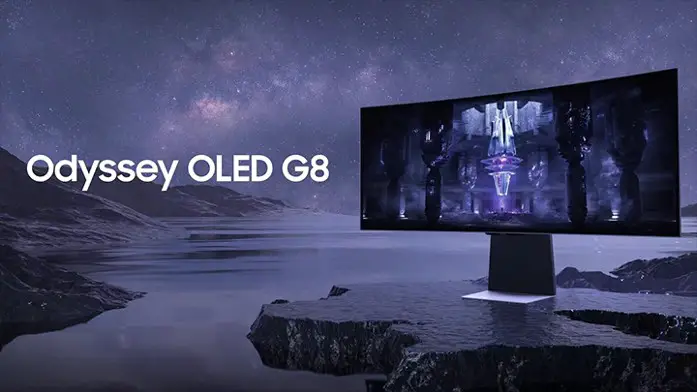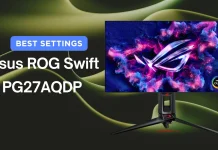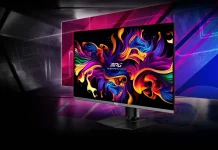Picture this: You’re deep into an intense gaming session, crouched behind cover in an epic shootout, sweat dripping down your forehead as you line up a crucial shot.
Suddenly, the screen goes dark, as if someone turned off the lights. Frustrating, right? Fear not, for we have the solution! In this comprehensive guide, we’ll show you how to unlock the full potential of your gaming experience with the Samsung Odyssey Neo G8 Monitor.
Say goodbye to dimly lit battlefields and hello to crystal-clear visuals that give you a winning edge over your opponents.
Table of Contents
Overview Of Odyssey Neo G8 Monitor
Before we delve into the settings, let’s acquaint ourselves with the Samsung Odyssey Neo G8 monitor. This monitor boasts an impressive 240Hz refresh rate, making it the top choice for gamers seeking seamless and fluid gameplay. Additionally, it supports HDR content, ensuring vibrant colors and improved contrast in compatible games and videos. With its high resolution and cutting-edge features, it’s no wonder many users turn to this monitor for both work and play.
Optimizing SDR Settings
- Picture Mode: Custom
- Start by setting the Picture Mode to “Custom” for personalized adjustments to your display settings.
- Brightness: Find Your Sweet Spot
- Adjust the brightness to your preference, typically within the range of 43 to 80, depending on your lighting conditions. A higher brightness level enhances vividness, while a lower setting is more comfortable for dimly lit environments.
- Contrast: Striking the Right Balance
- Begin with a contrast level of 75 as a starting point, but feel free to adjust within the range of 75 to 100 for your preferred visuals.
- Sharpness: Crisp Details
- Set sharpness to 60 to display crisp details without unwanted artifacts.
- Color Tone: Normal
- Keep the color tone on “Normal” for a balanced and natural color representation.
- Color Calibration
- Fine-tune colors with the following recommendations:
- Red: 50
- Green: 50
- Blue: 50
- Fine-tune colors with the following recommendations:
- Gamma Mode: Experiment
- Experiment with Gamma Modes 1, 2, and 3 to find your preferred level of contrast.
- Saturation: Personalize
- Start with a saturation level of 70 or 58 and adjust based on your preferences.
- Contrast Enhancer: Off
- Ensure the Contrast Enhancer is off to maintain consistent contrast without artificial enhancements.
- Black Equalizer: Enhancing Dark Scenes
- Set the Black Equalizer to 13 to improve visibility in dark scenes without compromising overall picture quality.
- Local Dimming: High
- Maximize contrast with Local Dimming set to “High” for superior display quality.
Recommended HDR Settings
- Picture Mode: Custom
- For HDR content, select the Picture Mode as “Custom” to create a tailored HDR experience.
- Brightness: Go Bold
- Maximize brightness by setting it to 100 for an immersive HDR experience.
- Contrast: Your Preference
- Set contrast to your preference, ranging from 75 to 100, to achieve your desired visual balance.
- Sharpness: Maintaining Clarity
- Maintain clarity by setting sharpness to 60, ensuring HDR content displays without artificial enhancement.
- Color Tone: Normal
- Retain a “Normal” color tone for a balanced and natural HDR color representation.
- Contrast Enhancer: Off
- Keep the Contrast Enhancer off to maintain an authentic HDR experience.
- Black Equalizer: Enhancing Dark Scenes
- Use a Black Equalizer setting of 13 to improve visibility in darker scenes while preserving overall picture quality.
- Local Dimming: High
- Maintain Local Dimming at “High” to maximize HDR’s enhanced contrast and vibrant colors.
Additional Tips for an Enhanced Viewing Experience
- Adaptive-Sync for Smoother Gameplay
- Enable Adaptive-Sync for a smoother gaming experience, especially if your graphics card supports G-Sync or FreeSync. This feature minimizes screen tearing and ensures fluid gameplay.
- HDMI vs. DisplayPort
- Choose between HDMI and DisplayPort based on your priorities, considering factors like color depth and refresh rate.
- Firmware Updates
- Periodically check for firmware updates to improve performance and add new features to your monitor.
- Troubleshooting Flickering
- If you encounter screen flickering, try turning off the monitor’s power using the OSD buttons and then turning it back on. Restarting your PC may also resolve issues.
- Size Matters: VESA Mount Adaptor
- Ensure the correct size when purchasing a VESA mount adaptor, especially for a 32″ model of the Odyssey Neo G8 (look for “G75T 32” with a ‘D’ letter).
- Understanding Refresh Rates
- Understand the relationship between refresh rates and tasks. Use the 240Hz refresh rate for gaming and switch to 120Hz for office work and video viewing.
Conclusion
The Samsung Odyssey Neo G8 monitor offers an exceptional visual experience for both gaming and work-related tasks. By fine-tuning your monitor settings for SDR and HDR content and following these recommendations, you can elevate your viewing experience to new heights. Remember, these settings serve as a starting point, so feel free to experiment and tailor them to your preferences and lighting conditions.
Additionally, consider the tips provided to optimize your overall experience and troubleshoot any minor issues that may arise. With the right settings and a bit of experimentation, you’ll fully appreciate the impressive capabilities of the Samsung Odyssey Neo G8 monitor, reveling in its stunning visuals, rich colors, and smooth gameplay.
So, set your preferences, fire up your favorite games, and get ready for a visual feast like never before with your Samsung Odyssey Neo G8 monitor. Elevate your gaming experience today!




